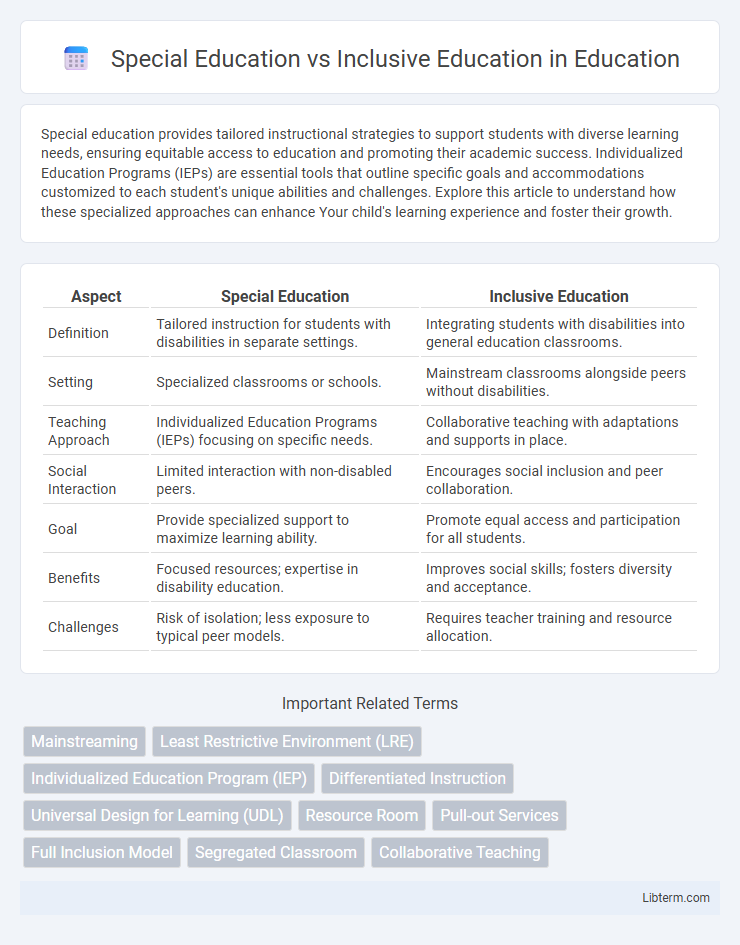Special education provides tailored instructional strategies to support students with diverse learning needs, ensuring equitable access to education and promoting their academic success. Individualized Education Programs (IEPs) are essential tools that outline specific goals and accommodations customized to each student's unique abilities and challenges. Explore this article to understand how these specialized approaches can enhance Your child's learning experience and foster their growth.
Table of Comparison
| Aspect | Special Education | Inclusive Education |
|---|---|---|
| Definition | Tailored instruction for students with disabilities in separate settings. | Integrating students with disabilities into general education classrooms. |
| Setting | Specialized classrooms or schools. | Mainstream classrooms alongside peers without disabilities. |
| Teaching Approach | Individualized Education Programs (IEPs) focusing on specific needs. | Collaborative teaching with adaptations and supports in place. |
| Social Interaction | Limited interaction with non-disabled peers. | Encourages social inclusion and peer collaboration. |
| Goal | Provide specialized support to maximize learning ability. | Promote equal access and participation for all students. |
| Benefits | Focused resources; expertise in disability education. | Improves social skills; fosters diversity and acceptance. |
| Challenges | Risk of isolation; less exposure to typical peer models. | Requires teacher training and resource allocation. |
Understanding Special Education
Special education provides personalized instruction and tailored support to students with disabilities, addressing specific learning challenges and developmental needs. It involves specialized teaching methods, adaptive materials, and individualized education programs (IEPs) to promote academic progress and skill development. Understanding special education requires recognizing its role in ensuring equitable access to education through targeted interventions and legal frameworks like the Individuals with Disabilities Education Act (IDEA).
Defining Inclusive Education
Inclusive education refers to an educational approach where students with diverse learning needs, including those with disabilities, learn together in the same classrooms. This model emphasizes accessibility, participation, and support within the general education environment rather than segregating students into separate special education settings. Inclusive education fosters social integration and equal opportunities by adapting teaching methods and providing individualized resources to meet all students' unique needs.
Key Differences Between Special and Inclusive Education
Special education involves tailored instructional strategies and resources designed solely for students with identified disabilities, providing individualized support often in separate classrooms. Inclusive education integrates students with disabilities into general education settings, promoting equal participation and collaboration alongside non-disabled peers while adapting curriculum and environment. The key difference lies in delivery: special education centers on specialized, segregated support, whereas inclusive education emphasizes access, belonging, and accommodation within mainstream classrooms.
Historical Evolution of Educational Models
Special education originated in the early 19th century with specialized institutions designed exclusively for students with disabilities, emphasizing segregation and tailored interventions. Inclusive education emerged in the late 20th century, driven by global policies like the UNESCO Salamanca Statement (1994), promoting the integration of students with disabilities into mainstream classrooms. This shift reflects a paradigm change towards equity, recognizing diverse learning needs within general education settings to foster social inclusion and equal opportunities.
Legal Frameworks and Policies
Legal frameworks for special education emphasize individualized support through laws like the Individuals with Disabilities Education Act (IDEA) in the United States, ensuring students with disabilities receive tailored educational services. Inclusive education policies promote the integration of all students within general education classrooms, supported by international treaties such as the United Nations Convention on the Rights of Persons with Disabilities (CRPD). These policies mandate equal access to education, focusing on removing barriers and providing accommodations to foster participation and learning for students with diverse needs.
Approaches to Curriculum and Instruction
Special education employs tailored curriculum modifications and individualized instructional strategies to address diverse learner needs, often utilizing specialized resources and small-group settings to maximize student progress. Inclusive education integrates students with and without disabilities within general education classrooms, emphasizing universal design for learning (UDL) and differentiated instruction to foster accessibility and participation for all learners. Both approaches prioritize student-centered methods, but special education focuses on individualized plans, whereas inclusive education aims for equitable access through collaborative teaching and adaptive curriculum frameworks.
Teacher Roles and Professional Development
Special education teachers specialize in personalized instructional strategies and individualized education programs (IEPs) to meet diverse learning needs, while inclusive education teachers focus on adapting classroom environments to support all students within mainstream settings. Both roles require ongoing professional development in differentiated instruction, behavior management, and collaboration with specialists to effectively address varied abilities. Emphasizing continuous training in Universal Design for Learning (UDL) and co-teaching models enhances teacher efficacy and student outcomes in both educational approaches.
Benefits and Challenges of Special Education
Special education provides tailored instructional strategies and support services designed to meet the unique learning needs of students with disabilities, leading to improved academic outcomes and personalized attention. However, challenges include limited resources, potential social isolation, and varying levels of teacher training, which can affect the quality and consistency of services. Despite these obstacles, special education remains crucial for fostering skill development and promoting independence for children with diverse learning requirements.
Advantages and Barriers in Inclusive Education
Inclusive education offers significant advantages such as promoting social integration, enhancing peer relationships, and providing access to diverse learning environments that cater to the unique needs of students with disabilities. However, barriers like insufficient teacher training, lack of appropriate resources, and resistance to change within traditional school systems can hinder effective implementation. Addressing these challenges requires targeted professional development, adequate funding, and a cultural shift towards acceptance and support for all learners.
Future Trends in Education for Diverse Learners
Future trends in education for diverse learners emphasize the integration of advanced technology, such as AI-driven personalized learning tools, to support both special education and inclusive education models. Data-driven interventions will enhance individualized support plans, promoting equitable access and improved outcomes for students with disabilities within general classrooms. Collaborative practices between special educators, general educators, and families will increasingly leverage digital platforms to foster inclusive environments that adapt to diverse learning needs.
Special Education Infographic

 libterm.com
libterm.com